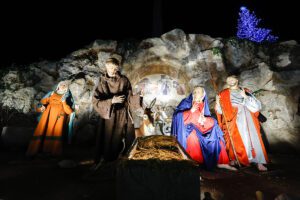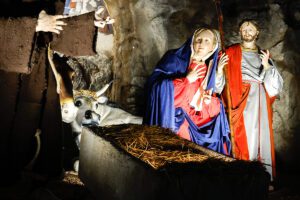Dear Brothers and Sisters,
Eight hundred years ago as the Church celebrated the latter days of Advent and prepared to commemorate the birth of Jesus, a cherished tradition in our lives as Christians was born.

Traveling from Rome to Assisi after having just received approval from the Pope for his brotherhood, Saint Francis stopped along the way in the little Italian town of Greccio. Having visited the Holy Land, the caves in Greccio reminded Francis of the countryside of Bethlehem. So, he asked a local man named John to help him celebrate with the faithful of the town the holy night of Christmas by replicating the original scene in Bethlehem.
Saint Francis’ biographers described in detail what then took place in Greccio: “On December 25, friars came to Greccio from various parts, together with people from the farmsteads in the area, who brought flowers and torches to light up the holy night. When Francis arrived, he found a manger full of hay, an ox, and a donkey. All those present experienced a new and indescribable joy in the presence of the Christmas scene. The priest then solemnly celebrated the Eucharist over the manger, showing the bond between the Incarnation of the Son of God and the Eucharist. At Greccio, there were no statues – just a manger, an ox, and a donkey; the nativity scene was enacted and experienced by all who were present.”
That Christmas night, eight centuries ago, began the tradition of the Nativity scene that we maintain in our churches and in our homes. For all its familiarity and the tendency that we may have to diminish its significance in the face of so many other competing symbols and traditions associated with Christmas, we would do well to pause at some point in this sacred season to reflect upon the message that lies at the heart of this treasured scene.
Like the faithful people of Greccio, Italy, look beyond the statues or figurines and imagine yourself in Bethlehem in a cave, with animals, straw, dirt, and a promise provided by a newborn baby boy.
In God’s plan to save His people, Jesus didn’t set Himself apart from the ordinariness of human life.

No, Jesus immersed Himself in the human condition of our world, for all its beauty and peace, its brokenness and pain, its sin and suffering. And He did so for a reason: In coming into our lives as a baby born in a manger – hardly a sign of power, self-sufficiency or pride – God lowered Himself so that we could walk with Him and He could stand beside us, not above or far from us, to lead us on the pathway to His promise of life and peace.
All too often, however, we are quick to leave the cave of Bethlehem and travel other pathways to achieve meaning and purpose in our lives. We set aside the message of salvation proclaimed throughout the ages by the life, love, mercy, and forgiveness of Jesus. We’re reluctant to heed his invitation to walk in his footsteps. Then we wonder why our lives are so unsettled and peace in our hearts, our homes and our world, appears to be so elusive. We wonder why God can’t provide us with a way out of suffering and pain in Israel, Ukraine, far too many places throughout our world, at our borders, in our neighborhoods, in our families and in our hearts.
Brothers and sisters, the good news and blessing of Christmas is that God has already provided us a way forward with hope if we are wise and humble enough to embrace the message of Bethlehem and the birth of his Son.
May we pray during these cherished days for peace in our troubled world, especially in the Holy Land where our Prince of Peace was born. May we open our hearts to the grace of God and the great mystery of salvation won for us through the simple story begun in a cave in Bethlehem that continues to be the world’s true and lasting reason for hope!
With gratitude for the privilege of serving as your Bishop and with prayers for a holy and blessed Christmas for you, your family and all you hold dear, I am
Faithfully yours in Christ,
Most Rev. Joseph C. Bambera, D.D., J.C.L.
Bishop of Scranton
